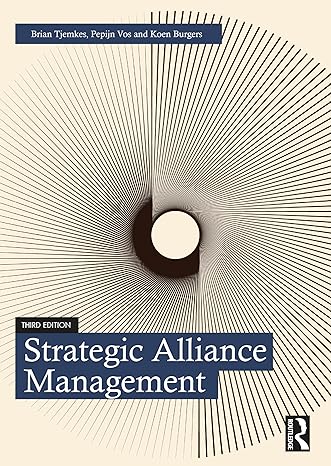The average UK household has about 4,000 of garments hanging in the wardrobe. Approximately 30 per cent
Question:
The average UK household has about £4,000 of garments hanging in the wardrobe. Approximately 30 per cent of this clothing has not been worn for over a year, mostly due to the fact that it no longer fts. This amounts up to £30 billion of unused clothing. Roughly 31 per Cross-sector alliances 233 cent of these clothes are thrown away and end up as landfll, amounting to roughly £10 billion of good-quality clothes. At the same time, there is a high demand for good-quality second-hand clothing, both in the UK and abroad, especially in developing countries. The ability to get access to good-quality second-hand clothing can fulfl demand at the same time as reducing pollution. That is why Marks & Spencer and Oxfam joined forces in their alliance called Shwopping.
Oxfam was established in 1942 as the Oxford Committee for Famine Relief by a group of Quakers, social activists and Oxford academics. This group campaigned for food supplies to be sent through the allied naval blockage in order to feed the starving population of Greece.
After the Second World War, the organization started to expand, and its frst overseas Oxfam was founded in Canada in 1963. The organization changed its name to Oxfam in 1965.
Oxfam is currently an international confederation of 18 organizations, working together with partners and local communities in more than 90 countries. The mission of Oxfam is to relieve people from poverty. To do so, Oxfam fnds practical and innovative ways to enable people to lift themselves out of poverty.
Marks & Spencer (M&S) is a major British multinational retailer. Founded in Leeds in 1884 by Michael Marks and Thomas Spencer, the company grew quickly, focusing mainly on the sale of clothes and food. Offering fair value for money was always a key feature for M&S, which established long-lasting partnerships with suppliers in order to do this. The company experienced healthy growth but went through tough times in the late 1990s. In 2004, a hostile takeover bid was made, which led to a change in leadership and a rebalanced strategy. Although the takeover bid was fought off, the new strategy also incorporated setting higher standards with regard to environmental and societal consciousness. Due to growing pressure on natural resources and poor global stewardship, M&S risked an increased cost base, growing diffculties in getting access to raw materials and increased volatility in the M&S global supply chain. To counter these threats, M&S launched its ‘Plan A’ in 2007. The goal of Plan A is to make M&S the world’s most sustainable retailer and improve the protection of the planet and its communities.
Questions 1 Describe the company interests of both Marks & Spencer and Oxfam to participate in the Shwopping alliance, and compare these to their joint interests. Which tension(s) do you observe, and how did (or may) the alliance partners deal with them?
2 Provide a systematic overview of management initiatives Marks & Spencer and Oxfam implemented to avoid and resolve conficts.
3 Explain why it would be difcult for competitors and other non-governmental organizations to mimic the success of the Shwopping alliance.
Step by Step Answer:

Strategic Alliance Management
ISBN: 978-1032119250
3rd Edition
Authors: Brian Tjemkes ,Pepijn Vos ,Koen Burgers






